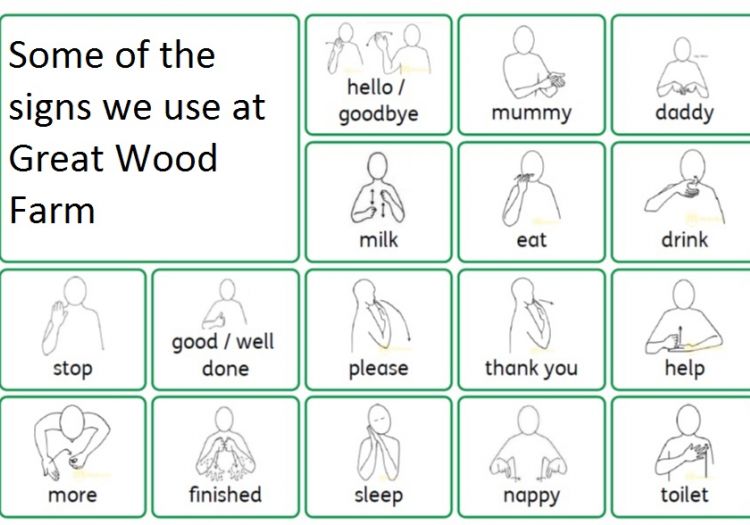Makaton Blog
An explanation of Makaton and how we use it at Great Wood Farm.
For October’s blog Kate has asked me (Totty, Early Years Teacher and Kindergarten Badgers Room Leader) to write about Makaton. This is something that I am personally very passionate about and believe that it is a wonderful communication tool, inclusive to all children and adults. But it is something that a lot of people may not be familiar with. Hopefully within this blog I will be able to answer some common questions about what Makaton is, why it is something that we use throughout the nursery and why I think it’s fantastic!
Recently staff across the nursery have taken part in some training, learning some basic Makaton signs and symbols. Using Makaton within our setting is something that we have been doing over the past few years with some staff previously completing their level 1, 2 and 3 certificates. However, we wanted to embed them deeper into everyday practice within the nursery ensuring that staff where all familiar with common signs and symbols and to foster a love and understanding of Makaton.
So, what is Makaton? Makaton is a unique way of communicating that is not only for those who have delayed speech and language or other communication struggles, but it is inclusive and accessible for all. It is a communication tool that incorporates signs, symbols, and speech. Signs are used alongside speech rather than instead of. The symbols tend to be used as an additional prompt and are particularly for those with limited speech or those who are unable to sign.
Although there are set signs for Makaton, it is important to remember that these are flexible and can be adapted for the individual if needed. For example, if they struggle to do a certain sign this could be adapted slightly to better suit them.
Similarly, to the sign aspect of Makaton the symbols should also be flexible. Although you can print off or recreate the official version of the symbol you should also be able to draw one on the spot when needed. This is why the symbols are simple drawings that basically depict what is being communicated.
You might be wondering why people bother to use Makaton if a child has no additional needs or speech delay. Well, it all boils down to the need for communication. Communication is an incredibly important skill needed within everyday life; in fact, it is arguably one of the most important skills for a person to possess. But communication is not just speech, if you watch someone in a conversation, they typically use their body language including hand gestures, eye contact and facial expressions as well as speech. This is all part of Makaton, hence why it is such a successful communication aid. Without some form of communication, we would struggle to complete many everyday tasks such as building relationships or asking for food and drink. A child’s understanding often develops at a faster rate than their speech. Signing therefore can be a useful tool during this period, preventing a child from getting frustrated and struggling to communicate their needs, wants, thoughts and feelings.
A question that many people often ask, or wonder is; will the use of Makaton and signing delay or discourage a child from speaking? This is not the case, in fact Makaton has been purposefully designed to support a child’s speech development. In fact, a variety of research suggests that the use of signs and symbols actually encourages the development of spoken word.
When helping children to express their emotions and feelings I particularly find Makaton useful. Introducing these signs to children allows for them to have another form of expression when it comes to trying to put across how they are feeling. This is something that we have been focused on recently in Kindergarten Badgers. Since encouraging these signs we have found children have tried to put this into practice using the signs to communicate their feelings to their peers. It really is amazing how quickly this has become embedded within our room.
As a nursery we try to model simple signs within talk and play with children. An example of this might be signing ‘thank you’, ‘more’ or ‘sleep’ during routines and interactions with the children. As well as using signs during these moments another popular time to teach new signs and practice previously learnt ones is during singing. Children love signing along to songs and signs learnt through song are then encouraged and used during play. For example, in the baby room they love to sing and sign along to ‘Old McDonald’, by doing this the children and staff now know the signs for a variety of different animals.
Hopefully now I have convinced you of the wonders of Makaton. But you might be left wondering where you can learn some signs and start incorporating to it into your life and day to day communication. The internet and youtube is full of lots of videos that you can watch to learn new signs. Two sites I have particularly found useful are the official Makaton charity (https://www.makaton.org/) and Singing Hands (https://singinghands.co.uk/). There are lots of useful free resources to be discovered on the official Makaton site including a sign of the week video, song sheets and much more. Singing hands have both a website and a youtube account where they, amongst other things, sign along to songs and stories.
I hope you have found this blog interesting and useful and if you have any questions, please feel free to come and find me or ask another member of staff.
Totty

